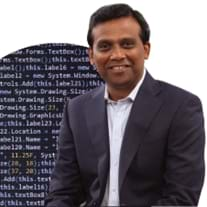Good Teachers Yield Promising Returns for Confident Students
Developing a strong future workforce starts with training teachers to be confident in their instruction of computer science, starting in students’ early school years.
Contributed by Ravi Kumar S.
President, Infosys Ltd. and Chairperson, Infosys Foundation USA

President, Infosys Ltd. and Chairperson Infosys Foundation USA
Over the past few years, there has been growing acknowledgment that it is important to make computer science a core component of K-12 education. And how could there not be? With 500,000 jobs currently available in the computing sector and projections that these jobs will grow at twice the rate of others, there is no ignoring that computer science is not just the future of work, but very much the present.
K-12 education should be setting our children up for postsecondary success, but multiple studies show that if students are not meaningfully exposed to STEM subjects by middle school, especially girls, they will never take an interest in them later on. How do we ensure that our children study these subjects early and continue them into their careers?
The answer is training teachers. Too often we bypass these critical members of our workforce, but that is a mistake. The average teacher will reach thousands of students throughout their career so their potential for impact in the classroom is huge. Developing a strong future workforce starts with learning computer science at a young age, and that means training and retaining confident teachers.
Here are five ways to make computer science professional development effective for teachers:
1. Offer multi-day trainings through multiple channels
Computer science can be challenging and intimidating. In order to get teachers more comfortable and familiar with the material, professional development should be sustained for multiple days rather than a one-day meeting or a single intervention seminar so they gain the confidence and competence to stand in front of their classes and teach the subject. Additionally, in-person trainings should be supplemented by online resources and coursework so teachers can continue to develop their skills and increase their facility with these concepts. The Every Student Succeeds Act (ESSA) outlines specific requirements for professional development and underscores the importance of sustained Professional Development (PD).
2. Create a community
Creating a community is key when it comes to teaching computer science, especially for teachers who are new to the subject. Successful PD should foster peer networks through online forums that encourage teachers to connect with one another, ask questions and share best practices so that success is shared across schools and states, and pain points can be worked through collaboratively.
3. Keep it collaborative and hands-on
Computer science is collaborative, so learning how to teach it should be as well. Beyond the hard-technical skills that are gained from the subject, students and teachers alike will benefit from a wide array of soft-skills — creativity, critical thinking, problem solving and collaboration. And these skills are necessary for all disciplines, so the applications are much wider than just the computing space. Furthermore, group learning helps to strengthen the community that teachers will walk away with once the PD is over.
4. Offer variety
Just like math, science or history, computer science covers a multitude of skills and subject areas, so there is no one-size-fits-all course when it comes to PD. In order to successfully integrate computer science principles across grade-levels and skill-levels, there needs to be a diverse offering so every teacher can find something that is relevant to their grade, ability and comfort-level.
5. Make it classroom relevant and contextual
PD should go beyond abstract theories and concepts, and the content should be relevant for the context in which it will be used. This means teachers should receive tools, such as lesson plans, teaching guides and other resources to support classroom instruction, and the materials should be adaptable to real-life scenarios and common core subjects so all students can take interest in what they are learning.
Underinvesting in the PD of teachers hinders the growth of our students. But if we ensure that teachers have the confidence and tools they need to bring the principles of computer science into the classroom, it will reverberate through to their students and help to light a spark in all students and build a healthy pipeline of tech talent for the future.
